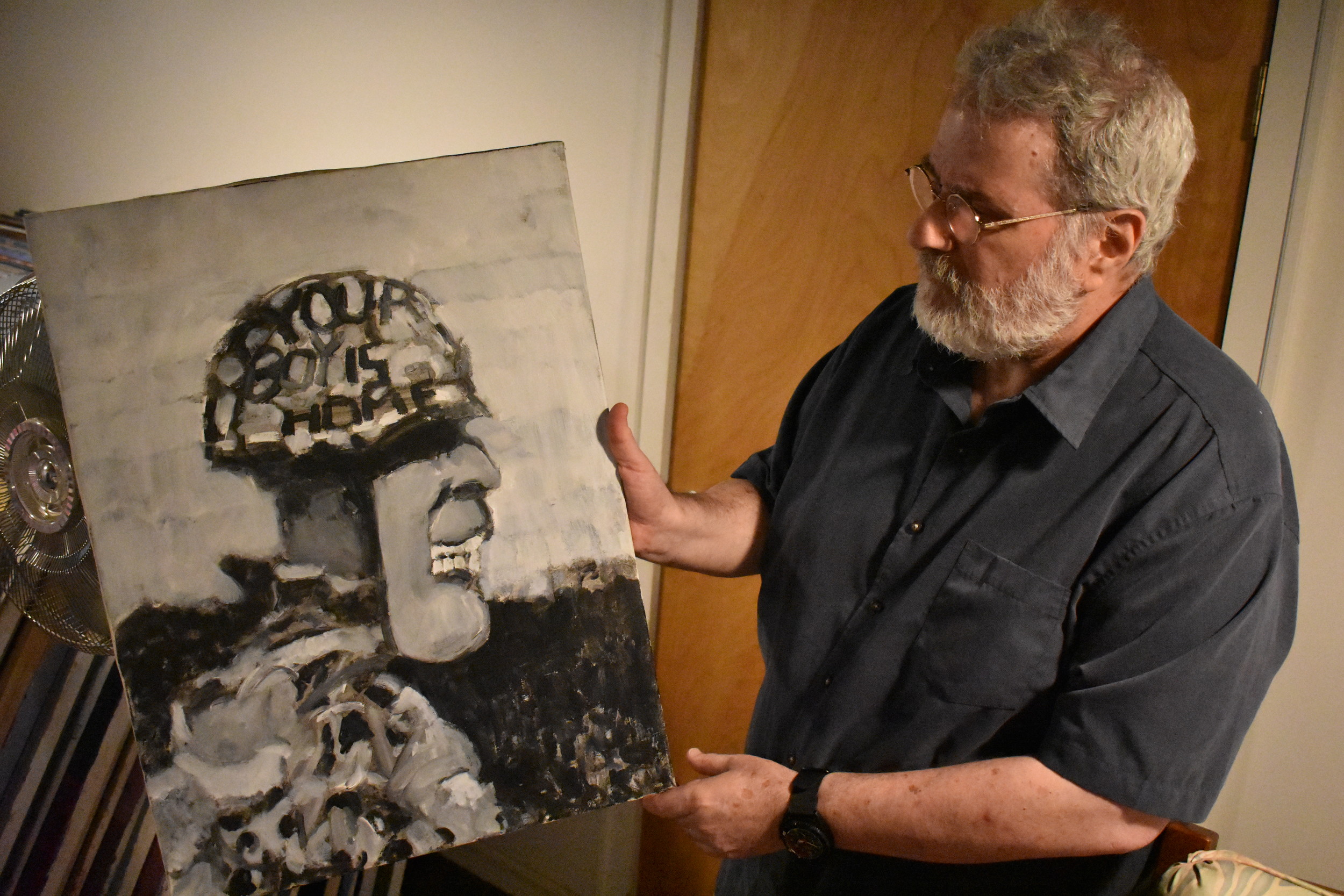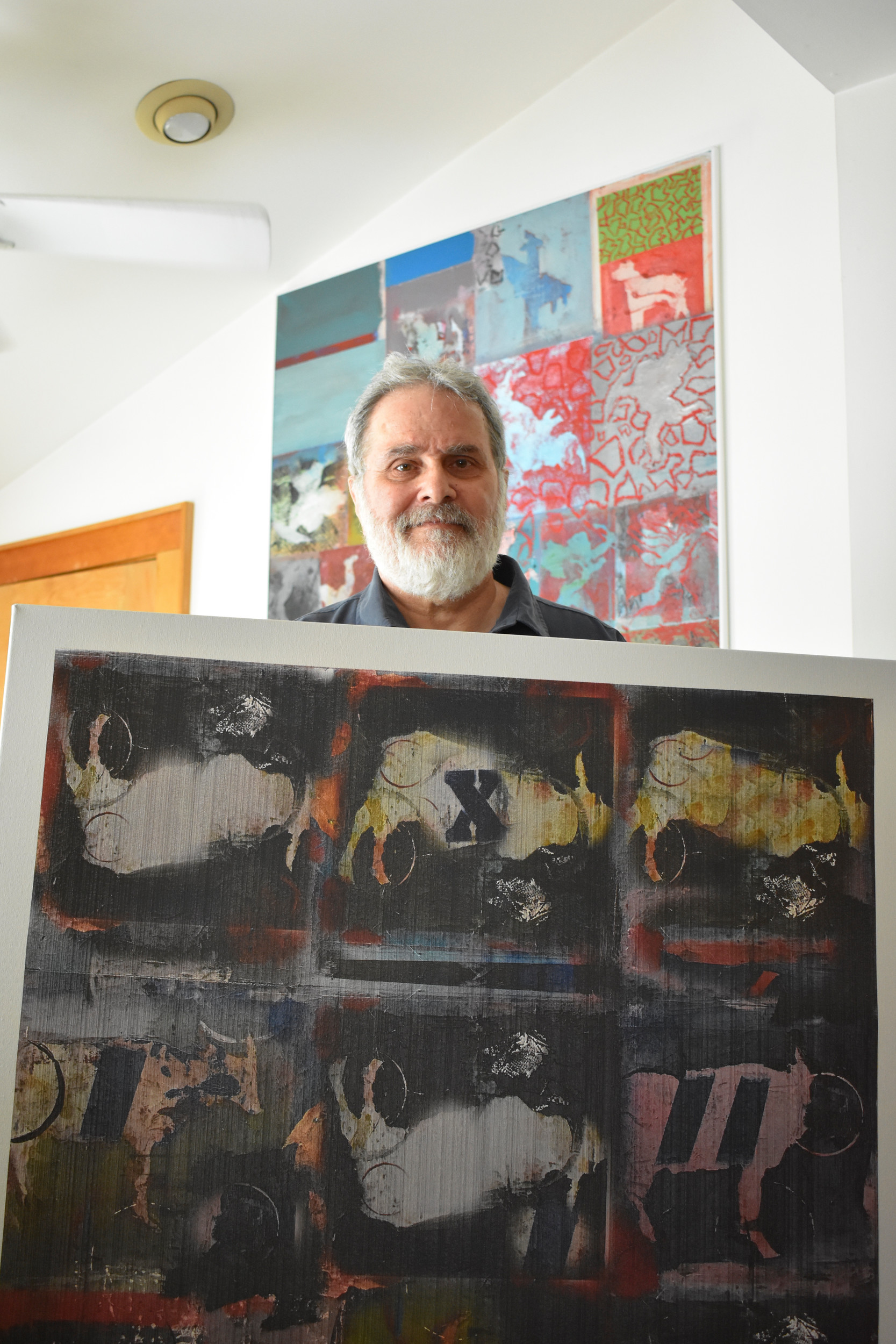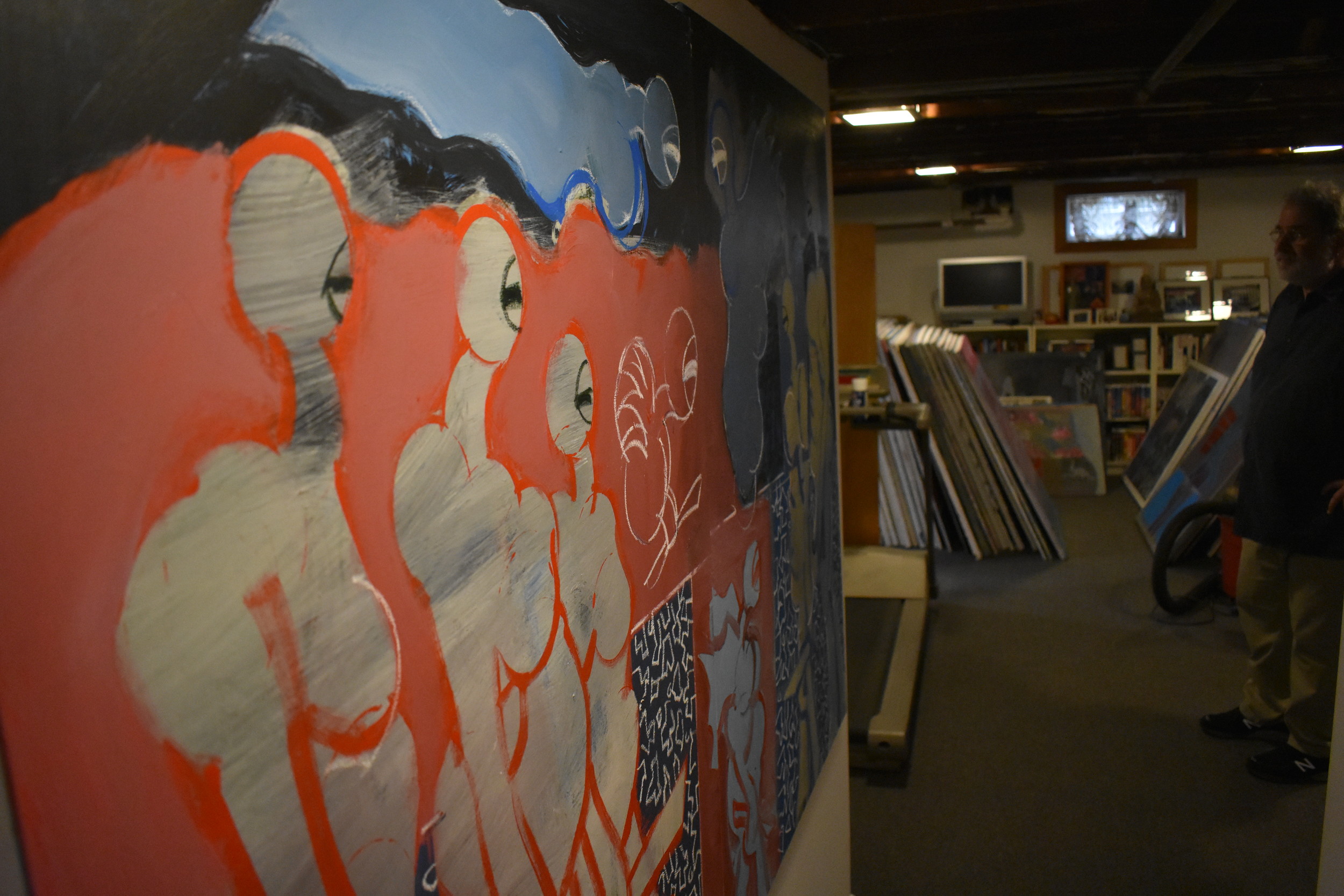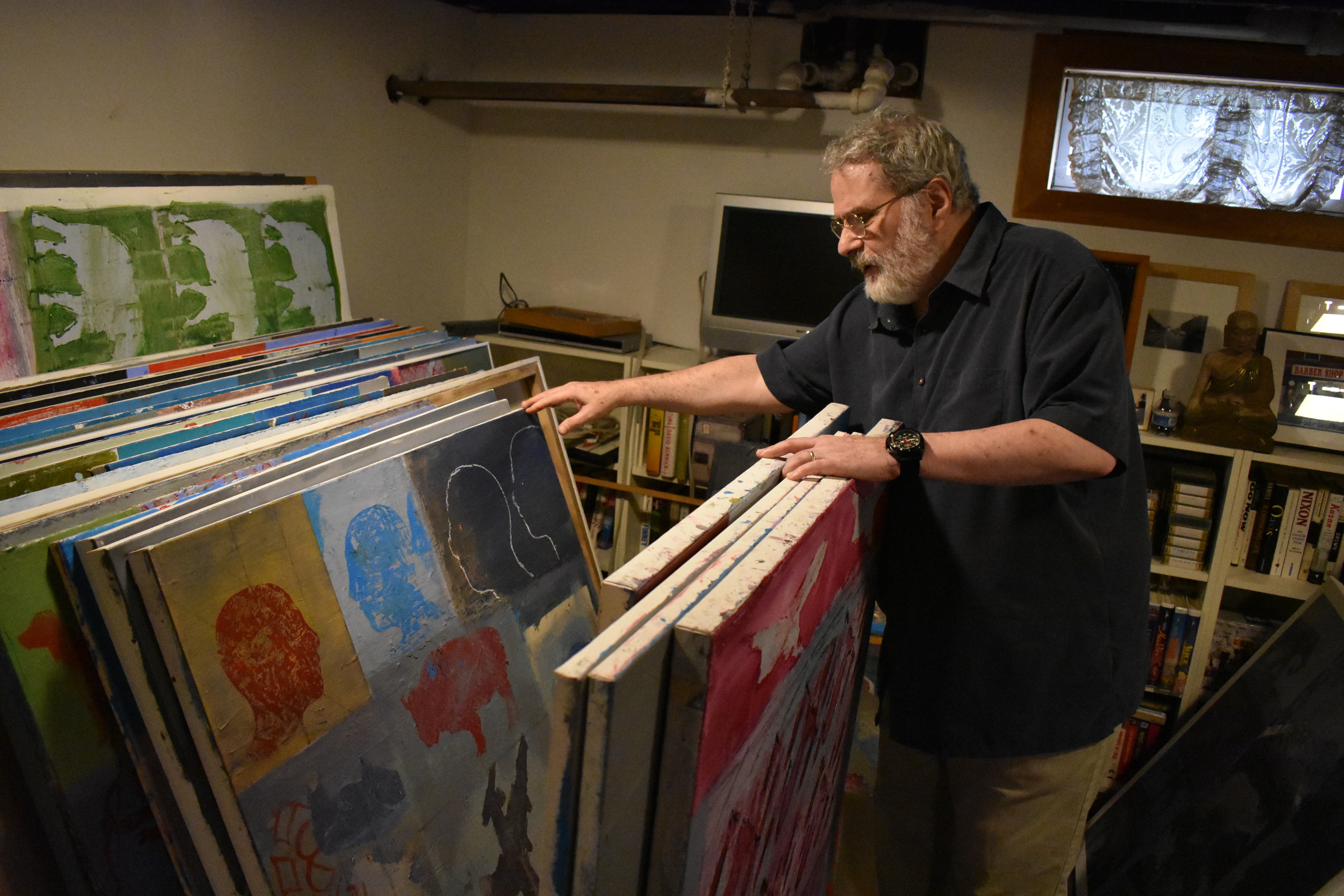Friday, April 19, 2024
RVC veteran puts thoughts to canvas
‘I don’t sit around waiting for inspiration’
Down the stairs and around a corner in Rockville Centre resident Neil Leinwohl’s basement, a 4-by-6-foot painting hangs prominently on the left-side wall.
“That’s called Last Laughs,” he said, eyeing the piece, which depicts oddly shaped creatures — weapons in hand — ready to fight. “It’s basically about the world today,” Leinwohl, 71, added softly. “People facing off against each other.”
A few feet away, another large painting occupying the wall features similar muscular warriors. “These are white blood cells attacking the myelin sheaths in my brain,” he said, adding that he was diagnosed with multiple sclerosis a few years ago. “That’s what I had in mind.”
“Painter” is just one of Leinwohl’s titles. Born in Brooklyn and raised in Merrick and Freeport, he graduated from Freeport High School and earned a scholarship to the School of Visual Arts in Manhattan. Bored with school after two years, he enlisted in the Army in 1966 and spent a year in Vietnam as a photographer and paratrooper.
He returned to the U.S. and spent two years with the 82nd Airborne Division in Fort Bragg, N.C. “There I was just basically jumping out of airplanes and taking pictures of other guys jumping out of airplanes,” Leinwohl laughed.
Fresh out of the service, he went to New York’s Parsons School of Design. “At this time,” he recalled, “I’m a 23-year-old Vietnam veteran smoking a cigar, hanging out with a bunch of fashion students.”
Leinwohl got a job at an art studio, later moving to a publishing company and ultimately working in advertising, which he did for the last 44 years of his career. As a writer, art director and creative director, he worked on ads and television commercials for projects such as Nancy Reagan’s “Just Say No” campaign, and the Metropolitan Transportation Authority’s “If You See Something, Say Something” initiative.
Train passengers on the Long Island Rail Road reported seeing something on an evening in 2004 — about a week after the Madrid train bombings — during Leinwohl’s daily commute home to Rockville Centre, where he has lived since 1981. The train had stopped at Jamaica because of a sick passenger, and Leinwohl began taking photos out the window of the city, beautifully lit by a golden sky.
“I turn around and there’s five or six policemen and they’ve all got machine guns,” he recounted. They asked him what he was doing, and he told them that photography was his hobby. He took photos of the passing landscapes during his commute almost every day, but this time, as the police explained to him, he was scaring passengers.
After escorting him off the train and taking his wallet and camera, police returned his belongings and cleared him to go. About a week later, he said, the MTA instituted a rule against taking photographs on its trains.
Just as Leinwohl took thousands of photos during his decades of LIRR commuting, his wife, Sela, said he takes his camera when they visit their daughter in Brooklyn. Carrying a digital camera and holding it at his chest, Sela said he is subtly just “clicking, clicking, clicking,” capturing passers-by in the neighborhood.
“I don’t even consider myself a photographer,” he said. “I take these pictures just to keep me busy.” He doesn’t buy into the concept of “the decisive moment,” a term coined in 1952 by Henri Cartier-Bresson, a founder of modern photojournalism, for the moment in which the visual and psychological elements of a photographer’s human subjects come together to perfectly express a situation.
“It’s almost impossible,” Leinwohl said. “How do you get your decisive moment? It’s luck. … You take a lot of pictures, every once in a while you’re going to find a great one. That’s all it is.”
One of his memorable photographs came by luck in Vietnam, when he saw a young girl getting every last drop out of a bottle of Coca-Cola. “Thirsty” is how he described the country.
Since retiring from the advertising agency three years ago, Leinwohl shifted his focus to creating acrylic paintings and inkjet prints, many of which involve cloning seemingly random images onto a digital canvas. Memories of Vietnam appear often in his work. The water buffalo, for example, is used in several pieces, including a digital, acrylic and inkjet print called “Animal Farm,” which was named a finalist in the juried art competition, Animal Kingdom: From Tame to Wild, sponsored by the Long Island Museum.
While hitchhiking back to the city of Bien Hoa during his year in Vietnam, he said, he spotted a water buffalo, which saw him and started ambling in his direction. He took out his rifle. Then a jeep came by, and he jumped in. “That was always something that stayed in my mind,” Leinwohl said. “These water buffalos are huge. I didn’t want to kill it, but I might have had to.”
The inkjet prints are mainly collages, including pictures that he has taken and manipulated, and his paintings incorporate a variety of people, animals, war symbols and colors in abstract ways. “I don’t sit around waiting for inspiration,” he said. “I just sit down and start doing something.”
As Leinwohl sorted through the stacks of paintings in his basement, he found one of his first. It was inspired by his return from the war and his exchange with his parents after he reached the airport in San Francisco.
“I called my parents to let them know I got to the United States,” he said, examining the painting of a masked man in military regalia. “My father picked up the phone, and I heard my mother in the back, going, ‘Sid, who is it?’ and he said, ‘Your boy is home.’”
Those words were brushed onto the man’s helmet in black paint.
“I guess that got stuck in my mind, and I didn’t think about that for years, but suddenly it came back,” he said, noting the subconscious mind’s role in his work. “It’s kind of like I’ve got this mask on. This is the guy who left. This is the guy that came back.”
“Very hard year for his mother,” Sela added, referring to her husband’s time in Vietnam. “That’s when she turned gray.”
“But then she dyed her hair,” he quipped, “so it didn’t matter.”
Sela just shook her head and smiled. “Men,” she said laughing, her voice almost musical. “Men do not have feelings like women.”
To view more of Leinwohl's work, visit neilleinwohl.info.
HELP SUPPORT LOCAL JOURNALISM
The worldwide pandemic has threatened many of the businesses you rely on every day, but don’t let it take away your source for local news. Now more than ever, we need your help to ensure nothing but the best in hyperlocal community journalism comes straight to you. Consider supporting the Herald with a small donation. It can be a one-time, or a monthly contribution, to help ensure we’re here through this crisis. To donate or for more information, click here.
Sponsored content
Other items that may interest you









